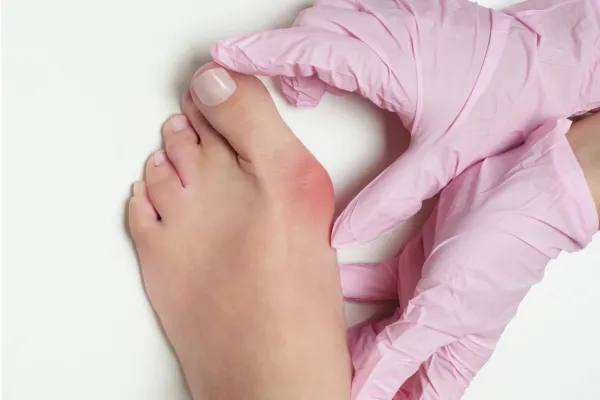
Bunions and Arthritis: How Joint Inflammation Accelerates Deformity
Bunions are a common and often painful foot condition that can significantly impact your daily life. When combined with arthritis, the condition can worsen more quickly, leading to severe discomfort and mobility issues. In this blog post, we’ll explore how arthritis accelerates the development of bunions and how to manage both conditions for better foot health.
What Are Bunions?
A bunion is a bony bump that forms at the base of the big toe, where the toe meets the foot. Over time, the big toe gradually shifts towards the second toe, causing the joint to protrude. This misalignment can lead to pain, swelling, and difficulty walking.
Bunions can develop due to various factors, including genetics, poor footwear choices, and abnormal foot mechanics. However, when arthritis is involved, the progression of bunions becomes much more complicated.
How Arthritis Affects Bunions
Arthritis is an inflammatory condition that affects the joints, causing pain, swelling, and stiffness. The two most common types of arthritis that affect the feet are osteoarthritis and rheumatoid arthritis.
1. Osteoarthritis and Bunions
Osteoarthritis (OA) occurs when the cartilage that cushions the joints breaks down over time, leading to pain, swelling, and stiffness. In the case of bunions, osteoarthritis can make the joint at the base of the big toe (the first metatarsophalangeal joint) more prone to wear and tear.
As the cartilage deteriorates, the joint becomes inflamed, which can further contribute to the misalignment of the big toe. The joint inflammation causes increased pressure on the toe, exacerbating the formation of a bunion. Over time, the combination of OA and the misalignment of the toe joint can accelerate the progression of the bunion, leading to greater pain and limited mobility.
2. Rheumatoid Arthritis and Bunions
Rheumatoid arthritis (RA) is an autoimmune disorder that causes chronic inflammation in the joints. Unlike osteoarthritis, RA primarily affects the lining of the joints, causing them to become swollen and painful. In the feet, this chronic inflammation can significantly worsen bunions.
The inflammation from RA can break down the ligaments and tendons around the big toe joint, further destabilizing the area and increasing the risk of bunion formation. Over time, the persistent inflammation associated with RA can cause the bunion to progress more rapidly, making it difficult to walk or wear shoes comfortably.
How Joint Inflammation Accelerates Bunion Deformity
Arthritis-related joint inflammation plays a key role in accelerating bunion deformity for several reasons:
1. Increased Joint Instability
Inflammation weakens the tissues that support the joint, including ligaments and tendons. As these structures lose their strength, the big toe becomes less stable, making it more likely to shift toward the second toe. This shift leads to the characteristic bony bump at the base of the big toe, which is the hallmark of a bunion.
2. Excessive Pressure on the Toe Joint
The inflammation in the joint caused by arthritis leads to swelling, which can put additional pressure on the toe. This added pressure exacerbates the misalignment, making the bunion grow larger and more painful over time. As the inflammation persists, the pain can become more intense, leading to greater difficulty with movement.
3. Increased Risk of Other Foot Problems
Arthritis can also affect the surrounding joints in the foot, causing additional deformities such as hammertoes or flat feet. These conditions can further alter the mechanics of the foot, increasing the strain on the big toe joint and causing the bunion to worsen more rapidly.
Managing Bunions and Arthritis Together
While arthritis can accelerate the progression of bunions, there are steps you can take to manage both conditions and prevent further damage to your feet.
1. Proper Footwear
Wearing shoes with a wide toe box and good arch support is essential for individuals with bunions and arthritis. Shoes that fit properly reduce pressure on the affected joint and provide stability, making it easier to move without pain.
2. Orthotics
Custom-made orthotics can help provide additional support to the foot and reduce the pressure on the big toe joint. Orthotics can also help correct any biomechanical issues that might be contributing to the development or worsening of the bunion.
3. Anti-Inflammatory Treatments
Managing the inflammation caused by arthritis is key to slowing the progression of bunions. Nonsteroidal anti-inflammatory drugs (NSAIDs), topical creams, and corticosteroid injections can help reduce swelling and pain in the affected joint.
4. Physical Therapy
Physical therapy exercises can help strengthen the muscles and ligaments around the big toe joint, improving stability and flexibility. Stretching exercises can also help relieve pressure on the toe joint and improve mobility.
5. Surgical Intervention
In severe cases, where conservative treatments fail to relieve pain or improve function, surgery may be necessary. A procedure called a bunionectomy can be performed to remove the bony bump and realign the toe. In cases where arthritis has severely damaged the joint, additional procedures, such as joint fusion, may be recommended to stabilize the area.
Conclusion
Bunions and arthritis are both challenging conditions, but when combined, they can significantly accelerate the progression of foot deformities. Arthritis-related inflammation weakens the structures around the big toe joint, leading to greater instability and increased pressure on the toe. Understanding how arthritis contributes to bunion formation can help you take proactive steps to manage both conditions effectively.
If you're dealing with bunions or arthritis, it’s essential to work with a podiatrist to develop a treatment plan tailored to your needs. At Prime Foot Clinic, we specialize in managing both bunions and arthritis to help you maintain mobility and comfort. Contact us today to schedule an appointment and learn how we can help you take care of your feet.



